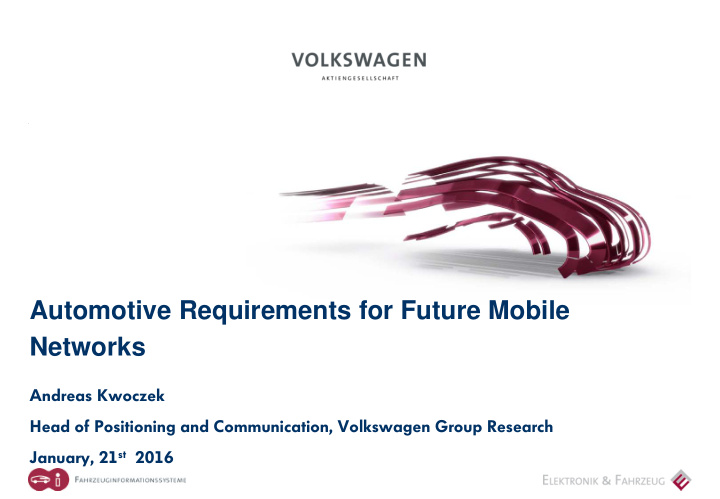



Automotive Requirements for Future Mobile Networks Andreas Kwoczek Head of Positioning and Communication, Volkswagen Group Research January, 21 st 2016
Automotive Requirements for Future Mobile Networks Motivation Customer Expectation Expected Mobile Data Traffic Vision of Automatic / Autonomous / Cooperative Driving Tele-operated Driving Requirements Quality of Service Ultra low End-to-End Latency High Data Rates Future work items Coverage Extension Predictive Communication Conclusion Seite 2
Customer Expectation Reliable connection in in all t ll tra raffic si situations ns a and nd loca cations ns for future advanced driver assistant systems (ADAS) QoS Communication usi sing ng d differ erent ent net network o oper erators, independent of the contract of the vehicle occupants (safety relevant info) Seite 3
Collective Perception of Environment and Related Data Rates Example See-Through Use Case Camera view of truck Video transmission from the trucks’ lane- departure-warning camera to the vehicle behind Video stream of 1.7 Mb/s @ 640x480 pixel @ 15 Hz Video stream of 12 Mb/s @ 1280x720 pixel @ 25Hz Use the camera signal of other vehicles in the environment model of ego-vehicle Enhanced reality projection for situation awareness e.g. overtaking a slow vehicle Video via 5G Seite 4
5G-Communication: Tele-Operated Driving Connected: ubiquitous coverage Control Data Mobile Communications Connection Video Data Video images of the surrounding and control inputs are transmitted between the vehicle and the remote operator workstation via mobile connection Quelle: ATZ, M. Lienkamp, TU München Teleoperated driving Seite 5
5G-Communication: Device-to-Device And Relaying Connected: ubiquitous coverage LTE 5G LTE 5G „mobile“ Base Base communication Station Station Seite 6 6
Predictive Communication Potential improvements: Using unique properties: Localization of scatters Deep fading prevention Form factor Prediction via: Channel estimation: Precoding Antenna placement Sensors, Maps, Extracted features, LOS to NLOS detection Cooperation Vector of motion Spectrum and TX technique selection Energy resources Strong reflection Weak reflection LOS Communication Seite 7
Conclusion Automotive Requirements for Future Mobile Networks Reliable and ubiquitous connection for future advanced driver assistant systems (ADAS) High data volumes at low latencies for future cooperative automatic driving functions for the Direct Communication between Vehicles and for applications like e.g. tele-operated driving. Communication using different network operators, independent of the vehicle occupants contract (safety relevant information must be forwarded) Complement to the WLAN-Based Vehicle2X Technology (IEEE 802.11p) Seite 8
Thank you! Seite 9
Recommend
More recommend